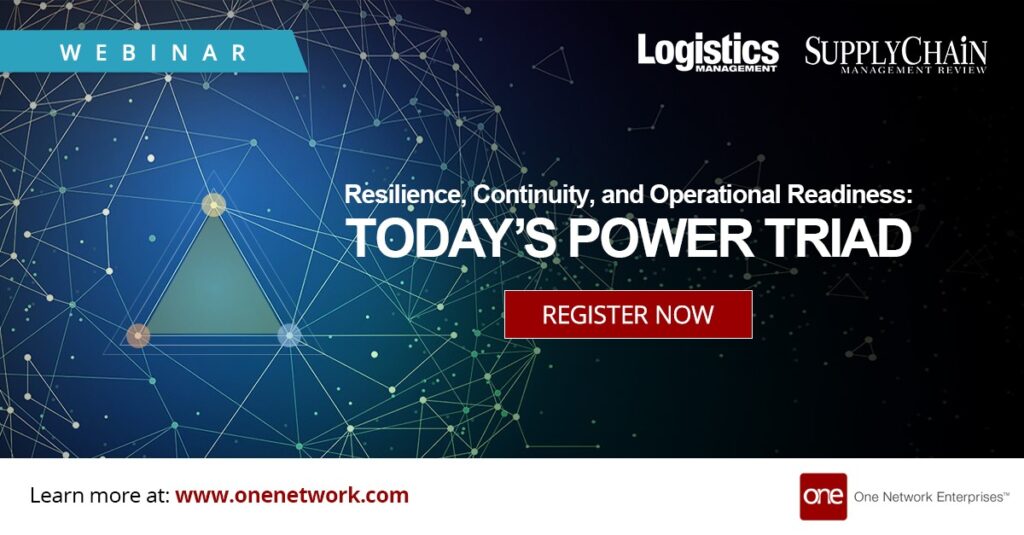This post has already been read 3194 times!
Joe Bellini Chief Operating Officer of One Network Enterprises, discusses supply chain control towers and their role in supply chain management.
This is part 1 of 2 an interview with Joe Bellini on Supply Chain Control Towers. (In part 2 of this conversation, Joe discusses machine learning and prescriptive analytics.)

Q: Hi Joe, thanks for chatting with me today. Let’s jump right in… What is a control tower?
Joe: I think analysts coined that term, because it is similar to an airport control tower in that you see the full network of activity, and can respond in real-time to changes. Of course, it translates more to demand than supply when you’re looking at a supply network. But I think that’s where the term came from.
Initially, a lot of executives were concerned around visibility because all these old ERP systems like Oracle and SAP and JDA, they’re all enterprise deployments. So, it’s the enterprise out, in a hub and spoke model. The enterprise manages all its data, all its trading relationships as a singular entity. And, then, on the spokes, it tries to let people know what it’s thinking, what’s going on, tries to share data, that kind of thing. And, so, everything tends to become isolated.
The example in my latest paper I used was, “What if instead of the United States having a common currency, every state had its own currency? How difficult would it be to execute trade?” And that’s why the EU moved to a common currency. Well, what happens to these companies is, that’s exactly how they operate. Data is their currency, but their data is trapped in all these ERP stovepipes, and it is very difficult for them to transact business, not only with the partners but even internal to these own companies.
"What if instead of the United States having a common currency, every state had its own currency? How difficult would it be to execute trade? Well, data is a company's currency, yet that is how they operate, with disparate data." – Joe Bellini Share on XAt one of our automotive implementations, they had over 120 different ERP instances, and again, that would be like every state having its own currency. It’s very difficult to operate. And, so, recognizing that it couldn’t be fixed overnight because of those architectures, they said, “Let’s overlay all that with a technology that will give us real time visibility to all those stovepipes.” And that’s why they ended up calling it a control tower.
Now, very quickly, what people came to the conclusion was, just seeing it doesn’t do us a lot of good. It’s not actionable. And, what we’d like is a network technology that not only can give us that control tower visibility but can actually execute a course correction just like they do at the airport when there are shifts in demand or supply or capacity throughout the network trading partners so that they can keep focused on customer service levels and least line of costs, because that’s the name of the game, right? If you can maintain the highest customer service levels at the least landed cost, then you win. And, so, that’s where it led to.
And that’s when you get into that next layer where if you want to make it actionable, now you need those SaaS services around demand, supply, logistics, fulfillment, that kind of thing. You get into a very robust feature function capability in the network itself.
And, so, what happens in our deployments is, over time they say, “Well, it’s crazy to try to do these feature functions in the ERP systems because that’s locked into that enterprise. Let’s go ahead and raise those features and functions, those capabilities in to the network, so everybody knows what’s going on. And then once we execute a transaction on the network, we’ll let the ERP systems know what happened because they’re very good at financials, general ledger, accounts payable, accounts receivables.”
So, that’s really what that’s all about and how it evolved.
Q: So, there is no physical control tower, cell phone tower. It’s an analogy, right, Joe?
Joe: Well not necessarily a physical entity like that, but there is a virtual control tower, dashboards which provide the visibility, analytics, and execution tools. Although, some companies do have a dedicated control tower room, or command center, where the software runs and the team operates, so in a sense, their’s is a physical control tower.
The way the network software works is, we’ll bring up an instance, and we’ll actually model in all those entities that I mentioned, all the trading partners, whether it’s the retailer, the distributor, the carrier, the supplier, the co-manufacturer, the brand manager. They’ll all be modeled as part of the network, and they’ll have different permissions about what they can see and what they can do as part of that network trading environment.
Recommended: Build Resilience, Continuity, and Operational Readiness (Webinar)
Everybody promotes their own data, almost like when you look at Uber, the rider can see all the drivers so they can get a ride, and the driver can see all the riders. So, they may want to pick which one they want in case they want to go home next, that kind of thing. That is a many-to-many architecture. So, that’s really what these networks are. The key is, it’s many-to-many.
So, if you’re on there as a network trading partner, whether you’re a carrier, a retailer, a distributor, warehouse manager, whatever, you can see what other people need, you can see demand shifts, you can see capacity shifts, and it’s all real time because the data only exists once.
When somebody joins the network, they can submit their own data and update it, and we do not allow it to be copied or transferred. What we do is allow other people to view that data, and that way we don’t get into the old data trap like ERP. They put the data in the data lake and then somebody plays with it, and then they might share it with somebody three or four days later after they decide what they want to do with it. In the network, in most cases the data only exists in one place, providing a single version of the truth, and it’s real time
It’s a SaaS instance, and there’s a lot of trading partners that are in that instance that have come into the network. They’ll go ahead and submit their data so they can execute trade whether they’re moving product, making product, selling product, whatever. And then the services that I mentioned earlier allow them to do that work, whether they want to process an order, plan for a shipment, let’s say, two weeks out, plan for capacity maybe 6 months or 12 months, out. Those are all services they can use on the network.
Q: Got it. Do you guys handle fixing data, data modeling, schema, taxonomy, nomenclature? Is that part of what you do? And, if not, how is that done? Because if everybody’s got their own ERP systems, I’m thinking you are going to have disparate data models and schemas, and even terminology.
Joe: That’s how we’re like the Federal Reserve Bank or the EU common currency. We recognize that all these stovepipes are all going to have their own data schema. So, we’ve got a standard set of API’s that we use depending on what the underlying system of record is, and then that data is pulled in as part of a federated master data management model. Because what happens in these networks is, the same item will have two different part numbers depending on where it’s getting routed.
So, if there’s a disruption, you want to be able to use an alternate supply, an alternate source, an alternate part number if it satisfies the item. So, you need to know what the item cross-references are. It’s like in the medical sector; there’s something called the “clinical cross reference” where physicians have approved other sources of supply when the primary source is not available. They can use it for the same or a similar medical purpose, that’s authorized by the clinical cross reference. All that’s modeled in.
The same thing happens in automotive, spare parts and maintenance repair. That whole federated master data management model is part of the network. You have to have it. That way, you can maintain a single version of the truth. It’s a demand-driven type response.
These days, everybody wants a responsive supply network because of what happened around the disruptions related to COVID, but they also want continuity, and they want to know that the network is designed for continuity if there are disruptions. And they want operational readiness. They don’t want to just be able to plan it and play around with a bunch of linear programs. There’s a lot of planning services out there, but the problem is that data is latent when they get it, and even when you plan it, you can’t execute anything. So, they want operational readiness. They want to be able to execute insights that the network may provide.
"Today continuity is obviously critical, as well as resilience. But operational readiness is also vital – you need to be able to execute the insights that the network provides." – Joe Bellini @onenetwork Share on XAnd a lot of them want to use the machine learning that we’ve added in. Machine learning is really good at making better predictions than some of the algorithms I designed in the past, probably around 5% to 10% better, but that’s a big difference. If you can predict an outcome 5% or 10% better on the demand side, that has a nice ripple effect all the way through the network.
Q: Right. A quick follow up question about the MDM capabilities you reference. You guys don’t do that in-house, do you? Do you use another vendor for that?
Joe: Yes, we do it, and it’s part of the SaaS instance. You’ve got to have a good multiparty master data management solution because when you set up a network, you need to model all the nodes and all the trading relationships. So, the data, of course, is the currency that we’re using, and then a day in the life is, “Well, what do people do with the data? What workflows and processes do they run? How do they make decisions? How do they execute orders? How do they source supply? How do they deliver it? How do they store it in the warehouse?” That’s all part of the network.
Q: I see that. You’re saying that it’s part of the SaaS instance that your customers get. But are those underlying MDM capabilities in the network something that One Network has created? Do you guys have a master data management tool, or have you partnered with someone who is giving you those MDM capabilities that you’re giving your customers?
Joe: Yes, we provide our own MDM capabilities. As I said, it’s part of the network instance, and we provide our MDM capabilities as part of that. The ERP systems tend to be the systems of record, and then we’ll pull that data in so that we can operate planning and execution for all the trading partners in the network. So, that master data management structure needs to be in place, or you wouldn’t be able to operate the network. And it has to be federated because we only have a single version of the truth. There’s no big data warehouse or data lake because that’s where you run into latency issues. So, the reason it’s federated is based on that permissibility structure, who’s going to get access to what data as the different trading partners update their data on a real time basis.
Q: Right. So, you’re saying, like, supply chain visibility, or even just the concept of a single network, that is all dependent on that MDM. That’s kind of the crux of it, right?
Joe: Yes, the data is the currency. You need to have a very strong modeling capability these days because everybody wants to model units. They don’t just want to model cases and truckloads. They want to know what is the individual unit and item because that gives them more flexibility when things change. So, you need to be able to represent it, and that’s what the modeling is. But then, once you represent to that detailed level, you need the data as the currency to populate it. And having master data management is extremely important because you don’t want to have data duplication. You also don’t want to have data latency. So, you need a real time single version of the truth that runs against that master data management infrastructure. That is what is in the fabric of the network.
And it fits in a blockchain. We’ve got three or four different blockchain technologies that can plug in, and we’ve got canonicals of other networks that will plug into our network where we need to execute maybe across a carrier network or that kind of thing.
Q: And as many One Network interviews as I’ve done, I not aware that you guys played in the master data space, yet that is at the foundation of what it is that you’re doing.
Joe: That’s right. What happens is, like at our automotive customer, they were uncomfortable with it at first, and they said, “We know you’re going to pull all the data and put it in the network, but we want you to pull it first into a data lake and then from the data lake into your network.” And we told them, “That’s kind of redundant. We really shouldn’t be doing that. We should serve it to the network first.” But they were nervous because we’re going to be taking data from over a hundred ERP instances.
Once they got comfortable with the network and the architecture, and they saw that that was just a waste of time and it only had potential to do harm because it might delay the data, they said, “You’re right. That data lake doesn’t make any sense because your network is inter-operating with the data from the systems of record and better to import it directly into the network so you can use it to plan and execute.”
Q: So they needed to understand how it works, build a little trust in the system, before they’d give up their old ways. That makes sense. Well Joe, thanks for walking me through this. I’m looking forward to chatting again soon, and digging in to the AI and prescriptive analytics side of control towers.
Joe: You’re welcome. I’m looking forward to it too. Thanks.
In part 2 of this conversation, Joe discusses machine learning and prescriptive analytics in the supply chain.

Recommended: Build Resilience, Continuity, and Operational Readiness (Webinar)
You might also like…
Recommended Posts
- Are Micro Fulfillment Centers the Next Frontier in Retail Logistics?
- Rethinking Defense Supply Chains with Network-Based Command Centers
- How to Use Predictive Analytics to Streamline Cross-Border Logistics
- AI Plus Humans for Resilient Freight Forwarding in a Complex World
- Modern Defense Supply Chains: The Essential Capabilities for Multi-Domain Operations
- Modernizing Defense Supply Chains - January 11, 2025
- Supply Chain Crossword Challenge - October 30, 2024
- Infographic: 6 Requirements for Transforming Supply Chains with Artificial Intelligence - June 10, 2024
